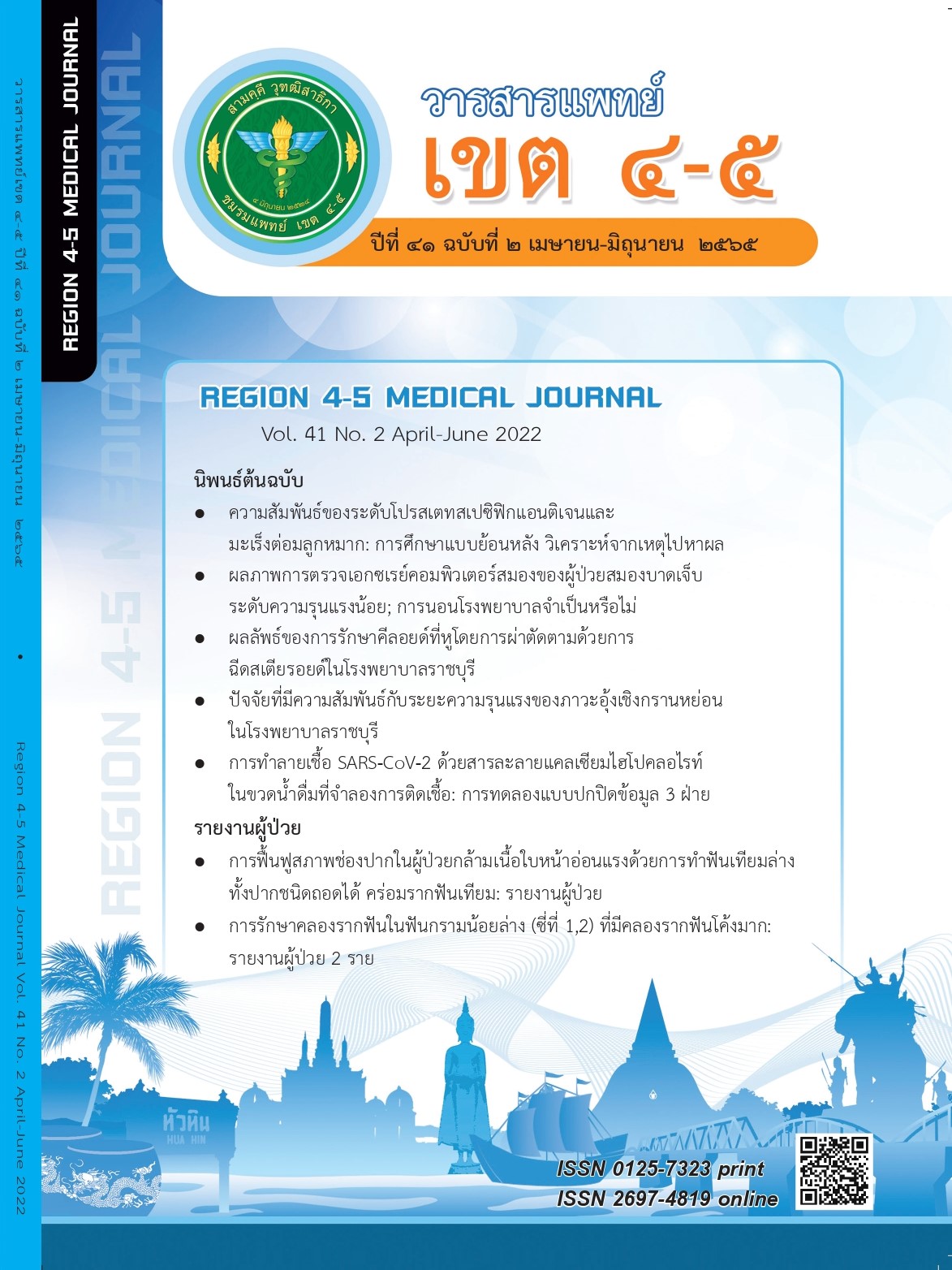Predictive Factors Associated With Success of High-Flow Nasal Cannula (Hfnc) for Covid-19 Related Acute Hypoxemic Respiratory Failure in King Narai Hospital, Lopburi
คำสำคัญ:
high flow nasal cannula (HFNC), COVID-19, acute hypoxemic respiratory failure (AHRF)บทคัดย่อ
Objective: The purpose were to assess patient characteristics on IMCU admission, clinical course, outcomes and examine COVID-19 patients with acute hypoxemic respiratory failure (AHRF) in order to identify factors associated with HFNC success
Method: The researchers performed a single center, retrospective cohort study in King Narai Hospital from April 1 to September 30, 2021 by enrolling 76 patients with AHRF from 1,934 confirmed COVID-19 admitted in the hospital. Patients were assigned to two groups based on HFNC success 45 patients and HFNC failure 31 patients.
Result: Mean age of enrolled patients was 56.2 years, 46 (60%) with DM were identified. The subjects with aging (>60 years) and ones with Risk factors ≥ 2 factors were associated with HFNC failure (p = .019, p = .028, respectively). Patients with HFNC success had a higher median of SpO2/FiO2 at 48 hr (178 % vs. 103%, p < .001) a significant lower median of CRP at initial IMCU admission and at 48 hr (93.5 vs. 134.3 mg/L, p = .001; 24 vs. 61.5 mg/L, p = .001; respectively), and a lower median of D-dimer (633 mcg/ml vs. 3,259 mcg/ml, p = .001). The success group also had a higher average ROX index at 6, 12, and 24 hr (p = .002, p < .001, and p < .001, respectively). Success HFNC was found in patients who initiated Favipiravir < 4 days of clinical manifestation and who were on intravenous Methylprednisolone 250 mg at ICU/IMCU admission (p = .043, p = .044, respectively). Median Hospital Length of Stay in success HFNC patients was 15 days, significantly shorter than the failure group (18 day, p < .036).
Conclusion: HFNC is effective to treat COVID-19 patients with AHRF who have predictive factors of HFNC therapy success. HFNC is safe to use in acute hospital at other ward outside ICU.
เอกสารอ้างอิง
Yuki K, Fujiogi M, Koutsogiannaki S. COVID-19 pathophysiology: A review. Clin Immunol 2020;215:108427.
Risitano AM, Mastellos DC, Huber-Lang M, et al. Complement as a target in COVID-19 ?.
Nat Rev Immunol. 2020;20(6):343–4.
Rello J, Storti E, Belliato M, et al. Clinical phenotypes of SARS-CoV-2: implications
for clinicians and researchers. Eur Respir J. 2020;55(5):2001028.
Vargas F, Saint-Leger M, Boyer A, et al. Physiologic effects of high-flow nasal cannula
oxygen in critical care subjects. Respir Care. 2015;60(10):1369–76.
Parke RL, Eccleston ML, McGuinness SP. The effects of flow on airway pressure during
nasal high-flow oxygen therapy. Respir Care. 2011;56(8):1151–5.
นัฐพล ฤทธิ์ทยมัย. การรักษาทางคลินิกด้วยออกซิเจนอัตราการไหลสูง Clinical Use of High-flow
Oxygen Therapy. กรุงเทพฯ: พริ้นท์เอเปิ้ล; 2564.
Raoof S, Nava S, Carpati C, et al. High-Flow, Noninvasive Ventilation and Awake
(Nonintubation) Proning in Patients with Coronavirus Disease 2019 with Respiratory
Failure. Chest. 2020;158(5):1992–2002.
นิธิพัฒน์ เจียรกุล. คำแนะนำการรักษาปอดอักเสบโควิด-19 [อินเตอร์เน็ต]. 2564 [เข้าถึงเมื่อวันที่ 15
ธันวาคม 2564]; เข้าถึงได้จาก: hhttps://www.thoracicsocietythai.org/2021/04/25/covid-
treatment-recommendations/
Goury A, Moussanang JA, Bard M, et al. Predictive factors associated with high-flow
nasal cannula success for COVID-19 related acute hypoxemic respiratory failure.
Health Sci Rep. 2021;4(2):1–5.
กรมการแพทย์ กระทรวงสาธารณสุข. แนวทางเวชปฏิบัติการวินิจฉัยดูแลรักษา และป้องกันการติดเชื้อในโรงพยาบาลกรณีโรคติดเชื้อไวรสโคโรนา2019 (COVID-19) ฉบับปรับปรุง วันที่ 2 พฤศจิกายน พ.ศ. 2564 สําหรับแพทย์และบุคลากรสาธารณสุข [อินเตอร์เน็ต]. 2564 [เข้าถึงเมื่อวันที่ 3 กุมภาพันธ์ 2565]; เข้าถึงได้จาก: https://covid19.dms.go.th/Content/.
Chen T, Wu D, Chen H, et.al. Clinical characteristics of 113 deceased patients with
coronavirus disease 2019: retrospective study. BMJ. 2020;368:m1295.
Najera H, Ortega-Avila AG. Health and institutional risk factors of COVID-19 mortality
in Mexico, 2020. Am J Prev Med. 2021;60(4):471−7.
Rice TW, Wheeler AP, Bernard GR, et al. Comparison of the Spo2/Fio2 Ratio and
the Pao2/Fio2 Ratio in Patients With Acute Lung Injury or ARDS. CHEST. 2007;132(2):410–7.
Kanjanavithayakul Y, Wongsrichanalai V. Correlation between the SpO2/FiO2 ratio and
PaO2/FiO2 ratio in ARDS. CHEST congress; 2019 April 10-12. Bangkok Thailand.
Roca O, Messika J, Caralt B, et al. Predicting success of high-flow nasal cannula in
pneumonia patients with hypoxemic respiratory failure: The utility of the ROX index. J Crit Care. 2016;35:200–5.
ธนรัตน์ พรศิริรัตน์, สุรัตน์ ทองอยู่. การพยาบาลผู้ป่วยผู้ใหญ่ที่มีภาวะพร่องออกซิเจนและได้รับ
การรักษาด้วยHigh Flow Nasal Cannula. เวชบันทึกศิริราช. 2563;13(1):60–8.
Wang L. C-Reactive protein levels in the early stage of COVID-19. Med Mal Infect. 2020;50(4):332–4.
Ali N. Elevated level of C-reactive protein may be an early marker to predict risk for
Severity of COVID‐19. J Med Virol. 2020;92(11):2409–11.
Tan C, Huang Y, Shi F, et al. C‐reactive protein correlates with computed tomographic
Findings and predicts severe COVID‐19 early. J Med Virol. 2020;92(7):856–62.
Tang N, Li D, Wang X, et al. Abnormal coagulation parameters are associated
with poor prognosis in patients with novel coronavirus pneumonia. J Thromb
Haemost. 2020;18(4):844–7.
Yu HH, Qin C, Chen M, et al. D-dimer level is associated with the severity
of COVID-19. Thromb Res. 2020;195:219–25.
Omore I, Brimah I, Shah J, et al. D-dimer as a surrogate marker of disease severity
in African American population with COVID-19 pneumonia: A Community Hospital
Retrospective Study.CHEST. 2021;160(4):A519.
Karatas E, Aksoy L, Ozaslan E. Association of Early Favipiravir Use with Reduced COVID-19 Fatality among Hospitalized Patients. Infect Chemother. 2021;53(2):300–7.
Pizon MA, Ortiz S, Holguin H, et al. Dexamethasone vs. methylprednisolone
high dose for Covid-19 pneumonia. Plos one. 2021;16(5):e0252057.
Edalatifard M, Akhtari M, Salehi M, et al. Intravenous methylprednisolone pulse as a
treatment for hospitalized severe COVID-19 patients: results from a randomised controlled clinical trial. Eur Respir J. 2020;56:2002808.
García-Pereña L, Sesma VR, Divieso MLT, et al. Benefits of early use of high-flow-nasal-
cannula (HFNC) in patients with COVID-19 associated pneumonia. Med Clin (Barc). 2021;S0025–7753(21)00322–5.
Mellado-Artigas R, Ferreyro BL, Angriman F, et al. High-flow nasal oxygen in patients with
COVID‑19 associated acute respiratory failure. Crit Care. 2021;25:58.
ดาวน์โหลด
เผยแพร่แล้ว
รูปแบบการอ้างอิง
ฉบับ
ประเภทบทความ
สัญญาอนุญาต

อนุญาตภายใต้เงื่อนไข Creative Commons Attribution-NonCommercial-NoDerivatives 4.0 International License.
ลิขสิทธิ์บทความเป็นของผู้เขียนบทความ แต่หากผลงานของท่านได้รับการพิจารณาตีพิมพ์ลงวารสารแพทย์เขต 4-5 จะคงไว้ซึ่งสิทธิ์ในการตีพิมพ์ครั้งแรกด้วยเหตุที่บทความจะปรากฎในวารสารที่เข้าถึงได้ จึงอนุญาตให้นำบทความในวารสารไปใช้ประโยชน์ได้ในเชิงวิชาการโดยจำเป็นต้องมีการอ้างอิงถึงชื่อวารสารอย่างถูกต้อง แต่ไม่อนุญาตให้นำไปใช้ในเชิงพาณิชย์




